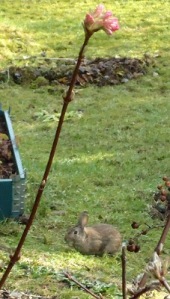I have a thorny problem.
One which requires diplomatic skills. And whilst I do have experience of what to do when a neighbouring country invades (I was interning at the UN when Kuwait was invaded by Iraq), going to war with the neighbours really isn’t an option here.
My invading foe is brambles. And they’re invading vigorously from two out of three of the neighbouring gardens that adjoin my floral borders.
Big snaky triffidy evil prickly nasty brambles. On a quest for territory. My territory. Sure, there are other foes encroaching into my patch (nettles, ground elder, bindweed – even a jaunty jasmine) but none of these threaten to poke my eyes out when I’m not paying attention. And for the most part they can be kept at bay easily enough, by remedial actions that take place solely within my territorial borders.
But not brambles. A little chopping back from my side of the fence is the equivalent of a testosterone overload to a drunken thug. “Bring it on” they cry, whilst sending out four more invading arms.
No. It seems to me that this bramble battle can’t simply play out within my own patch.
At this point, I should add that all my neighbours are very nice. (If you’re reading, I really really like you). But it is probably fair to say that with one exception, they are really not gardeners. One actively hates gardening. And I’m sure they have no idea of the invading power of a hormone crazed bramble on the rampage.
So these brambles really do require a UN Security Council intervention and coalition attack forces.
My conundrum is this:
1. Do I take the mature, correct, morally responsible (but embarrassing, awkward and potentially time consuming) option of discussing this with the brambles’ hosts in the hope we can reach mutual agreement?
If so, is there a win-win that doesn’t involve me doing their weeding? Forever?
2. Do I take the easier and not-entirely-unprecedented approach of nipping round when they’re out and removing the offending thugs?
This could be the outcome of option one anyway….
But, this approach would involve extensive convincing of myself that my actions would be those of a benevolent helpful fairy, as opposed to a nosey trespassing neighbour from hell. And I’d have to remove all those brambles myself.
3. Do I take a lesson from the Gulf War and use sneaky chemical warfare? Is a strong systemic weed killer, applied from my side, enough to take out – or at least set-back – this invading foe, without me having to cross my borders?
This could kill the plant back and I could just prune off the stuff on my side. But is it morally wrong? And would it even work? These brambles are tough and I don’t know if anything this side of Jupiter will take them out!
Any advice?
Seriously, the UN are lightweights compared to the moral dilemmas we gardeners face! Any thoughts, precedents and alternative tactics welcome! Otherwise I’ll just have to end up doing the right thing 😉



